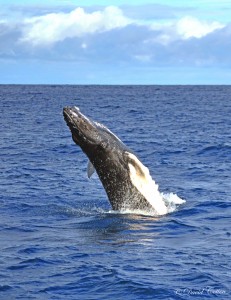Aloha,
We had a lot of fun on our Tuesday Whale Watch Cruises. The weather was great, and we ran too many cruises to tell you what we saw on each…but suffice it to say, there was a lot of action. Pods of Mom and baby seemed to gravitate towards our idling boats all day. We all saw competitive pods charging around on the surface. As usual with a competitive pod, there was lots of head lunging and throat inflation to see, and lots of trumpeting to hear. When we deployed our hydrophone throughout the day, we got to enjoy a veritable symphony of whale songs. Most of the whales we were listening to were not extremely close, but once in awhile we were able to pick out a singer nearby. We did see breaching, tail lobbing, and peduncle throws throughout the day from both adult humpbacks and calves.
Mahalo,
Claire
Captain Claire’s Humpback Fact of the Day: Researchers studying the totally geographically isolated Arabian Sea Humpbacks have recently noted that these Humpbacks sing songs that are a whole level less complex than the songs Humpbacks in every other ocean of the world sing. Arabian Humpback songs are comprised of notes, making phrases, which are repeated in the same order, while other Humpbacks group the phrases into themes and the repeated themes comprise the song. If I’m interpreting this correctly, the Arabian Humpbacks’ version of say “Old McDonald Had a Farm” would feature only one farm animal, and they’d be singing about that one animal over and over and over. Humpbacks elsewhere would be able to use the structured verse to sing about lots of different animals on the farm…If there are any music theorists out there please help me out.

